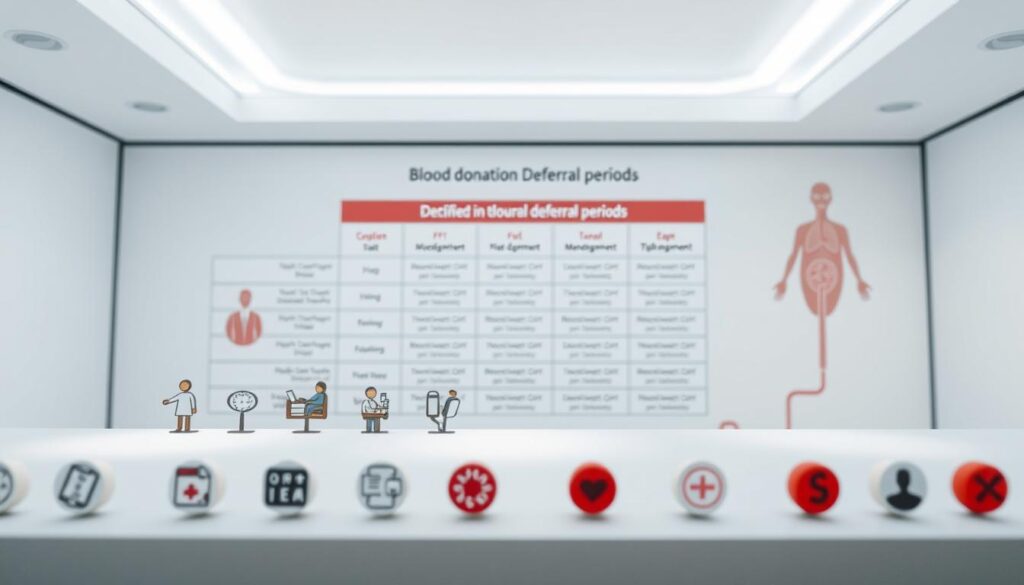
Could something as simple as a vacation stop you from saving a life? While many people assume blood donation is straightforward, eligibility criteria involve far more than just showing up. Temporary restrictions, health conditions, and even recent travel can impact your ability to give—sometimes in ways you’d never expect.
Every donor undergoes a thorough screening process to protect both their well-being and the safety of recipients. Factors like medications, iron levels, or recent tattoos might delay your ability to contribute. Even common experiences—like pregnancy or visiting certain countries—can trigger deferral periods.
Why does this matter? The rules aren’t meant to exclude willing donors but to ensure everyone’s safety. Temporary restrictions often resolve with time, while permanent deferrals are rare and medically necessary. Staff at donation centers review your health history and lifestyle details to make real-time decisions.
Honesty during screening is non-negotiable. Whether you’re giving whole blood, platelets, or plasma, requirements vary—and so do the reasons for deferral. Understanding these guidelines upfront helps avoid surprises and keeps the blood supply secure for those who need it most.
Key Takeaways
- Medical history, medications, and recent travel can temporarily prevent donation
- Eligibility rules differ for whole blood, platelets, and plasma donations
- Most deferrals are short-term and resolve after specific waiting periods
- Permanent bans are rare and based on high-risk health conditions
- Donation center staff make final eligibility decisions during screening
- Full transparency during screening protects donor and recipient safety
Understanding Blood Donation Eligibility

Did you know over 6.8 million people in the U.S. give blood annually? This lifesaving act starts with clear eligibility guidelines that protect both donors and recipients. The process adapts as medical knowledge evolves, ensuring safety remains the top priority.
Key Eligibility Guidelines
To be eligible to donate, you’ll meet basic requirements like age and weight minimums. Most centers require donors to weigh at least 110 pounds and be 17 or older. Health evaluations check iron levels, blood pressure, and potential exposure risks.
Recent tattoos or piercings? Some states impose 3-month waiting periods. Medications like blood thinners or acne treatments might require temporary deferrals. Staff review these factors case-by-case during screening.
Screening Process Overview
Your donation experience begins with a confidential health questionnaire. You’ll answer questions about travel history, sexual health, and medical conditions. Trained specialists review responses and perform quick physical checks.
Guidelines vary between whole blood, plasma, and platelet donations. Plasma donors often need higher protein levels, while platelet donations require specific platelet counts. Centers update requirements annually based on FDA regulations and new research.
Remember: Complete honesty during screening helps staff make safe decisions. Most temporary deferrals resolve within weeks or months, letting you contribute later. When in doubt about your status, contact local centers for personalized guidance.
What Disqualifies You from Donating Blood

Every day, thousands of potential donors discover temporary barriers they never anticipated. While enthusiasm to help saves lives, eligibility rules exist to protect both contributors and recipients. Let’s explore the most frequent hurdles—many of which resolve with time.
Recent medical treatments often trigger short-term pauses. Dental work or routine vaccinations typically require 24-hour to 4-week waits. Surgeries and hospital stays might delay contributions for several months. Always share these details during screening—staff assess risks case by case.
Prescription medications play a bigger role than many realize. Blood thinners, acne treatments, and certain antibiotics can affect donation safety. Travel to malaria-prone regions or Zika-affected areas brings 3-month deferrals. Even domestic trips involving tick bites might require temporary holds.
Lifestyle choices like fresh tattoos or piercings lead to 3-12 month pauses depending on state regulations. High-risk behaviors involving needles or unprotected sex also impact donor status. Iron deficiency or low hemoglobin levels? These common issues often resolve with dietary changes.
Chronic conditions like HIV, hepatitis, or some cancers result in permanent deferrals. However, many managed illnesses—such as diabetes or hypertension—may still eligible you to participate. When in doubt, complete the screening process. Most temporary restrictions lift faster than you’d expect.
Age and Weight Requirements
Your journey as a blood donor starts with two foundational checks: meeting age thresholds and maintaining safe weight levels. These safeguards ensure your body can handle the donation process without health risks.
Minimum Age Guidelines
You must be at least 17 years old to give blood in all states. First-time donors under 23 face extra checks—staff will confirm your height-to-weight ratio meets safety standards. There’s good news for seasoned contributors: experienced donors have no upper age limit if they pass health screenings.
Weight Requirements Explained
Centers require donors to weigh at least 110 pounds minimum. But here’s the twist: taller individuals often need higher weights. This table clarifies common scenarios:
| Age Group | Minimum Weight | Special Notes |
|---|---|---|
| 17-23 (first-time) | 110 lbs + height ratio | Chart-based assessment |
| 24+ | 110 lbs | Universal baseline |
| 67+ (new donors) | 110 lbs | Platelet/plasma restrictions |
“We prioritize donor safety through these measures,” explains a Red Cross medical director. “Weight thresholds prevent dizziness and ensure adequate blood volume recovery.”
First-time contributors aged 67+ can only give whole blood initially. Plasma centers cap new donor ages at 70. Remember—these rules exist to protect you while helping others. Always check your local center’s specific guidelines before visiting.
Health and Medical Conditions

Your current health status plays a bigger role in blood donation than you might think. Many enthusiastic contributors discover their medical history determines eligibility more than age or weight. While most conditions won’t permanently exclude you, understanding how they affect donation safety is crucial.
Chronic and Acute Conditions
Well-managed chronic illnesses rarely prevent donation. Diabetes and high blood pressure typically won’t stop you if medications keep them stable. Eligibility hinges on whether your treatment plan allows normal daily activities without complications.
Feeling under the weather? Acute issues like fevers or infections require rescheduling. “We want donors to thrive during and after their contribution,” notes a Red Cross nurse. Recovery periods ensure your system isn’t strained while giving.
Permanent deferrals apply only to specific situations:
- Active cancer treatments
- HIV or hepatitis infections
- Certain heart conditions
Donation staff review your medical history to spot risks. Transparent communication about symptoms or diagnoses helps them protect both you and recipients. Temporary holds often lift once illnesses resolve or treatments stabilize.
Remember: Being eligible to donate means you’re healthy enough for the process and your blood won’t harm others. When in doubt, complete the screening—many assume they’re excluded when they actually qualify.
Travel-Related Deferrals

Your passport stamps could hold more significance than you realize when it comes to blood donation. International trips often trigger temporary holds—not to limit generosity, but to protect recipients from region-specific health risks.
Travel History and Malaria Risk
Visiting malaria-prone areas requires careful screening. Donation centers enforce a 3-month waiting period after returning from countries where this mosquito-borne disease circulates. “Malaria parasites can survive in stored blood for weeks,” notes a CDC health advisor.
Lived abroad long-term? Residing in malaria-risk regions for over five years means a 3-year deferral from your departure date. Those who’ve undergone malaria treatment face the same extended pause—the infection can linger undetected.
Your itinerary details matter. Staff review:
- Specific destinations outside the United States and Canada
- Travel dates and duration
- Activities like rural stays or medical visits
These rules apply even if you never felt ill. Tropical resorts and urban areas get equal scrutiny—mosquitoes don’t respect city limits. Bring exact travel dates and locations to your screening for faster assessments.
Most deferrals are temporary precautions. Mark your calendar and return when your waiting period ends. Your global adventures make stories—and eventually, they’ll help save lives too.
Medication and Vaccination Considerations

Popping a daily vitamin or managing a chronic condition? Your prescriptions and shots might affect donation plans more than you realize. While most treatments won’t stop you from giving, screening staff need full transparency to protect everyone involved.
How Medicines Influence Eligibility
Over 90% of common medications—like allergy pills or thyroid drugs—don’t impact donation. But blood thinners or acne treatments containing isotretinoin require temporary pauses. “We’re not judging your health needs,” says a Red Cross phlebotomist. “We’re ensuring medications won’t cause reactions during or after your gift.”
Bring a complete list of prescriptions, supplements, and over-the-counter drugs to your appointment. Antibiotics often trigger short deferrals until infections clear. Drugs for autoimmune diseases or cancer may indicate underlying conditions that disqualify.
Post-Vaccine Donation Rules
Got your flu shot yesterday? You’re likely cleared to donate immediately. But live-virus vaccines—like those for measles or yellow fever—require 2-4 week waits. COVID-19 vaccines have no waiting period unless you feel side effects.
| Vaccine Type | Waiting Period | Notes |
|---|---|---|
| Flu (inactivated) | None | Donate same day |
| MMR (live virus) | 4 weeks | Includes chickenpox |
| Hepatitis B | None | If no symptoms |
Staff check vaccine dates against FDA guidelines during screening. Donors receiving immunoglobulin injections for rabies or tetanus face 3-month holds. Always share immunization records—it helps centers make safe, informed decisions quickly.
Deferral Periods and Waiting Times

Timing matters more than you think when giving blood. Deferral periods act as safety buffers—specific waiting times between events and your next eligible donation. These pauses protect both donors and recipients by allowing your body to recover and reducing transmission risks.
Common scenarios have distinct timelines. A flu shot might require no delay, while malaria exposure needs months. Check this reference table for clarity:
| Situation | Waiting Period | Notes |
|---|---|---|
| Dental cleaning | 24 hours | No surgery required |
| Malaria-risk travel | 3 months | Applies to 100+ countries |
| Blood transfusion | 1 year | Applies to plasma donors |
“Deferrals aren’t punishments—they’re precautionary measures,” explains a Stanford Blood Center coordinator. Short-term holds (1-30 days) often follow minor procedures or seasonal illnesses. Medium pauses (1-12 months) apply to international travel or pregnancy.
Longer deferrals span years for issues like residing in mad cow disease regions. Always note the exact date your waiting period began. Centers track these timelines rigorously—your future donation could arrive sooner than expected.
When your hold lifts, contact the center to confirm eligibility. Many donors cycle through multiple deferrals over their lifetime. Each completed waiting time brings you closer to making another life-saving contribution.
Whole Blood, Plasma, and Platelet Donations
Your choice to give whole blood, plasma, or platelets unlocks unique ways to save lives. Each method serves different medical needs and follows distinct safety protocols. Understanding these differences helps maximize your impact while protecting your health.
Whole blood donation collects all components at once. You’ll wait 8 weeks between sessions—the longest recovery period. This allows your body to replenish red cells fully before contributing again.
Plasma and platelet contributions work differently. During plasma donation, machines return red cells to your bloodstream. This lets you give more frequently—up to 13 times yearly. Platelet collection follows similar principles but focuses on clotting components.
| Donation Type | Frequency | Key Requirement |
|---|---|---|
| Whole Blood | Every 56 days | 110 lbs minimum |
| Plasma | Every 28 days | Higher protein levels |
| Platelets | Every 7 days | Healthy platelet count |
Annual limits prevent over-donation. “We calculate totals across all donation types,” notes a Stanford Blood Center coordinator. Your eligibility might vary between methods based on iron levels or recent travel.
Discuss options with staff during screening. You could qualify for one type while paused from others. Flexible donors help maintain stable supplies for emergencies and chronic treatments alike.
Lifetime and Temporary Deferrals
Deferrals aren’t closed doors—they’re timed pauses in your lifesaving journey. Most donors face temporary holds rather than permanent bans. Centers design these safeguards to protect everyone involved while keeping donation opportunities open when possible.
Temporary Deferral Reasons
Common short-term pauses include recent international travel, seasonal illnesses, or low iron levels. Medications like antibiotics or acne treatments may delay your ability to give. Donors often become eligible to donate again after completing waiting periods—usually days to months.
Pregnancy triggers a 6-week hold post-delivery. Tattoos and piercings require 3-12 month pauses depending on state regulations. “These time frames let your body recover and reduce transmission risks,” explains a blood bank coordinator.
Permanent Deferral Reasons
Lifetime bans apply only to specific health conditions. HIV, hepatitis B/C, and certain blood-borne illnesses prevent donation permanently. Genetic disorders like Creutzfeldt-Jakob disease or variant CJD also lead to indefinite deferrals.
While rare, these restrictions ensure recipient safety. Many chronic conditions like diabetes or high cholesterol may still eligible you to participate if managed well. Centers reassess guidelines annually—what disqualified someone a decade ago might not apply today.
Remember: Temporary holds don’t reflect personal health judgments. They’re precautionary measures with expiration dates. Check your eligibility status periodically—your next blood donation could be closer than you think.
